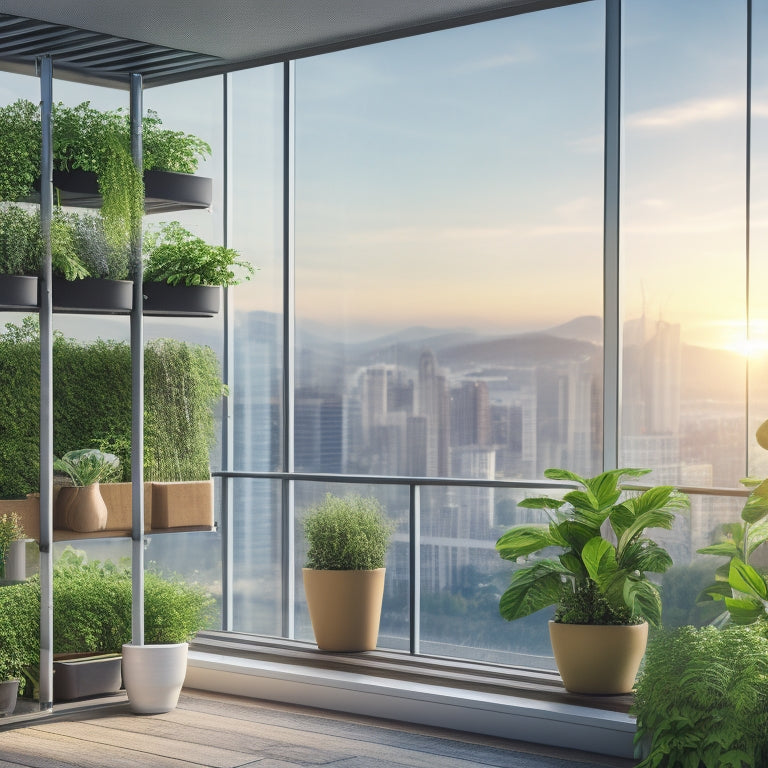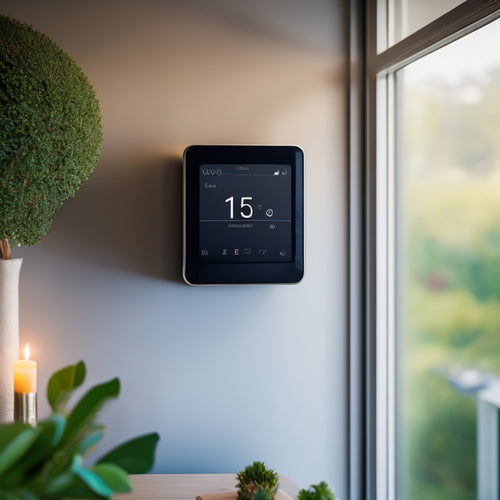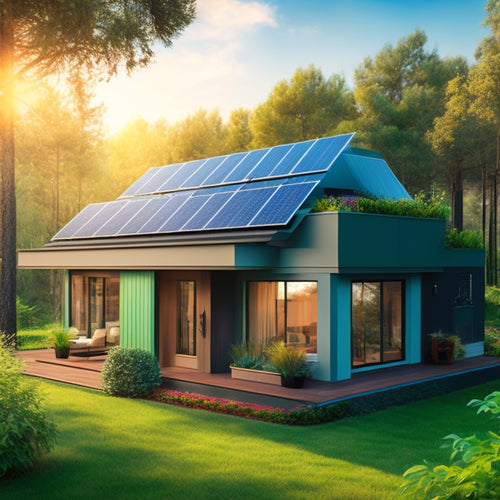
5 Solar-Powered Vertical Farming Tips for Urban Homes
Share
When creating a solar-powered vertical farm in your urban home, you'll want to start with the right solar panels, considering your energy needs and budget. Next, maximize your space by enhancing layouts, using vertical arrangements, and partitioning for different crops. Choose low-maintenance, indoor-thriving crops like leafy greens and herbs. Implement water conservation strategies like drip irrigation and rainwater harvesting to minimize waste. Finally, regularly monitor and maintain your systems to guarantee peak growth and yields. By following these tips, you'll be well on your way to a thriving urban farm - and there's even more to investigate to take your project to the next level.
Key Takeaways
- Select the right solar panels for your urban farm, considering energy needs, panel efficiency, and installation constraints.
- Optimize vertical farm space by implementing layouts that maximize crop yields, reduce disease and pests, and utilize solar power.
- Choose low-maintenance, high-yielding crops like leafy greens and herbs that thrive in indoor conditions and support companion planting.
- Conserve water with strategies like drip irrigation, rainwater harvesting, and mulching to minimize waste and reduce reliance on municipal sources.
- Regularly monitor and maintain your solar-powered vertical farm to ensure optimal growth, yields, and system performance.
Selecting the Right Solar Panels
How much energy will your solar-powered vertical farm require? This depends on the size of your farm, the type of crops you're growing, and the lighting they need. To determine your energy needs, research the wattage required for your specific setup.
Next, consider the solar panel types that'll work best for you. Monocrystalline panels are efficient but pricey, while polycrystalline panels are more affordable but less efficient. Thin-film panels are another option, offering a balance between cost and performance.
As you investigate your options, keep in mind that renewable energy solutions like solar power can greatly reduce greenhouse gas emissions and provide a stable energy supply. Additionally, investing in solar power can also help you achieve energy independence, which is vital for a hassle-free experience.
When it comes to installation considerations, think about the size and layout of your roof, as well as any shading issues that might affect panel performance. By choosing the right solar panels, you'll be well on your way to utilizing the power of the sun for your vertical farm.
Maximizing Vertical Farm Space
By optimizing your vertical farm's layout, you can maximize space and increase crop yields.
Consider a vertical layout that allows for easy crop rotation, ensuring each plant receives the right amount of sunlight and nutrients. Partition your space into sections, dedicating specific areas to different crops. This will enable you to rotate crops efficiently, reducing disease transmission and pests.
With the integration of cost-effective electricity generation from solar panels, you can power your vertical farm's lighting and irrigation systems. High-efficiency solar panels can provide a reliable source of energy, reducing your reliance on fossil fuels.
Make the most of your wall space by using trellises or vertically stacked planters. This will allow you to grow vining plants like tomatoes or cucumbers, freeing up floor space for other crops.
With a well-planned vertical farm, you'll be able to harvest a diverse range of crops in a small area, achieving freedom from grocery store reliance.
Choosing the Best Crops
Now that you've optimized your vertical farm's layout, it's time to focus on selecting the best crops for your space. Consider plants that thrive in indoor conditions and require minimal maintenance.
Leafy greens like kale, spinach, and lettuce are ideal, as they're easy to grow and can be harvested continuously. Herbs like basil, mint, and cilantro are also great options, adding flavor and fragrance to your cooking.
Implementing energy-efficient practices, such as Fast Charging Infrastructure(https://www.illchancenthislater.com), can also reduce your carbon footprint. Additionally, integrating Energy Storage and Grid Resiliency solutions can optimize your farm's energy usage.
Implement crop rotation to avoid depleting soil nutrients and prevent pests and diseases. Practice companion planting by pairing crops that complement each other, like planting marigolds with tomatoes to deter nematodes.
Water Conservation Strategies
What's the most precious resource for your vertical farm, aside from sunlight? Water, of course! Conserving this important resource is essential for a sustainable and thriving urban farm.
You can't control the weather, but you can control how much water you use. Renewable energy, such as solar power, can also greatly reduce greenhouse gas emissions and contribute to a sustainable energy future renewable energy.
By adopting renewable energy sources, you can reduce your carbon footprint and create a more environmentally friendly vertical farm.
Here are three water conservation strategies to get you started:
-
Drip irrigation: This method delivers water directly to the roots, reducing evaporation and runoff. It's a transformative approach for vertical farms, where every drop counts.
-
Rainwater harvesting: Collect and store rainwater in tanks or barrels to supplement your water supply. This reduces your reliance on municipal water and decreases your environmental impact.
-
Mulching and cover cropping: These techniques help retain soil moisture, reduce evaporation, and suppress weeds that compete for water.
Monitoring and Maintaining Systems
You've implemented water conservation strategies, and now it's time to focus on the systems that keep your vertical farm running smoothly.
Regularly monitoring system performance guarantees peak growth and maximum yields. Keep an eye on environmental factors like temperature, humidity, and light exposure, as these can impact system performance.
Just like solar panel maintenance, regular cleaning and upkeep are essential to prevent energy loss and maintain efficiency. By integrating energy storage systems, you can stabilize power supply and guarantee reliability.
Check for signs of wear and tear on pumps, pipes, and other equipment, and perform routine maintenance to prevent breakdowns. Make adjustments as needed to maintain a balanced ecosystem.
Frequently Asked Questions
Can I Use Solar-Powered Vertical Farming in Areas With Low Sunlight?
You can still grow your own food in areas with low sunlight by choosing low-light crops or supplementing with artificial lighting, ensuring a steady harvest and ultimate freedom from grocery stores.
How Do I Control Pests in a Solar-Powered Vertical Farm?
You'll want to control pests naturally, without harming your crops or the environment. Use organic solutions like neem oil, diatomaceous earth, and introduce beneficial insects to attract natural pest predators, ensuring a healthy and thriving harvest.
Are There Any Specific Regulations for Urban Solar Farming?
As you sow seeds of freedom in urban agriculture, you'll find regulations sprouting up like weeds; check local zoning laws, building codes, and energy efficiency standards to guarantee your solar-powered oasis doesn't wither under bureaucratic red tape.
Can I Integrate Solar-Powered Vertical Farming With Existing Gardening Systems?
You can seamlessly integrate solar-powered vertical farming with existing gardening systems, incorporating hydroponic systems and vertical structures to maximize space and efficiency, allowing you to grow more with less effort and energy.
What Is the Average Cost of Setting up a Solar-Powered Vertical Farm?
You'll need an initial investment of around $5,000 to $10,000 to set up a solar-powered vertical farm, but don't worry, you'll reap long-term savings on energy costs and enjoy fresh produce year-round, giving you the freedom to live more sustainably.
Related Posts
-

Smart Energy: Greener Homes With Connected Power Devices
You can control and optimize your energy consumption with smart energy devices, reducing your carbon footprint by up ...
-

3 Green HVAC Filters for Solar-Powered Homes
When outfitting your solar-powered home with an HVAC system, you'll want to choose filters that align with your commi...
-

3 Earth-Loving Furniture Tips for Energy-Smart Homes
When furnishing your energy-smart home, you have the power to reduce your carbon footprint greatly by making consciou...


